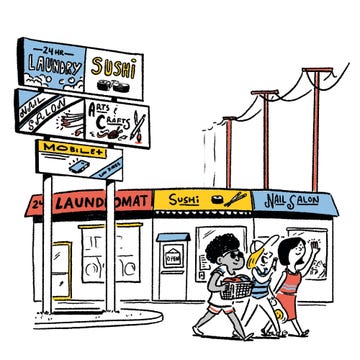Nobody likes the L.A. freeways. That’d be nuts. But I think I love them. Look, I know. For 85 years, the freeways of Los Angeles have crushed neighborhoods, often displacing or upending the poorest ones. They’re fountains of pollution and planet-destroying carbon. They’re congested. They kill people. They preempted what could have been the best mass transit system in the world. All the bad things!
Yet under the cathedral vaults of their fly-away overpasses, racing along their thousand-mile-an-hour straightaways past glittering towers, threading the knotted topologies of stack interchanges—I can’t help but be amazed. They should never have been built, sure, but consider the magisterial hubris of that tragedy. More than 500 linear miles of precisely banked and tuned asphalt and concrete drape across L.A. like a Lovecraftian caul. Every other freeway in the world is modeled on these awful, hopeful monsters.
The philosopher Jean Baudrillard famously wrote that driving was a “spectacular form of amnesia,” and I get it. I’ve been entranced. But I think Baudrillard was wrong. The freeways encode L.A.’s deep memory. Old maps and surveys—even from before it was called Los Angeles—show their future routes, like ley lines. You know the 110 from Long Beach to Downtown? In the 1850s, half-wild horses pulled coaches along what would become its right-of-way, transporting passengers from the port at San Pedro to the Plaza, dodging grapevines.
This article appears in Issue 30 of Alta Journal.
SUBSCRIBE
Today, driving a freeway is usually about as much fun as inhaling smog. But when it’s late at night and the roads have emptied—maybe you have the windows rolled down and KROQ turned up—you can unintentionally get going just slightly too fast on the banked curve that drops in from the top of the five-level interchange connecting the 105 to the 110 and stay on target toward the turrets of Downtown. It was cyberpunk before they invented the word.
Like the best art installations, L.A.’s freeways couldn’t exist anywhere else. Engineers built them for speed, to travel through a city without ever touching it. But it didn’t work. Oops! Accidentally built a megastructure, a most authentically Los Angeles thing: delightful and blighted, necessary and useless, alienating and comforting, fast and slow.•
Adam Rogers is a journalist and bestselling author. His book Proof: The Science of Booze, about the science of making and consuming alcohol, was a New York Times bestseller; winner of the IACP Best Wine, Spirits, and Beer Book Award; and shortlisted for the PEN/E.O. Wilson Literary Science Writing Award. Rogers’s new book, Full Spectrum: How the Science of Color Made Us Modern, looks at the long (and rainbow-shaped) arc of color—its physics and chemistry, but also how humans make it, and how our eyes and brains construct it in our minds. A Los Angeles native, Rogers is a senior correspondent at Business Insider who now lives in the Bay Area.













